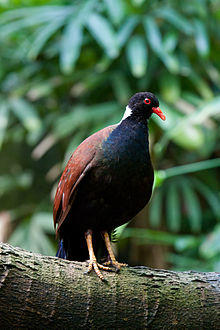| Pheasant pigeon | |
|---|---|
 | |
| O. n. aruensis | |
| Scientific classification | |
| Kingdom: | Animalia |
| Phylum: | Chordata |
| Class: | Aves |
| Order: | Columbiformes |
| Family: | Columbidae |
| Genus: | Otidiphaps Gould, 1870 |
| Species: | O. nobilis |
| Binomial name | |
| Otidiphaps nobilis Gould, 1870 | |
The pheasant pigeon (Otidiphaps nobilis) is a species of large terrestrial pigeon. It is the only species of the monotypic genus Otidiphaps. The pheasant pigeon is found in the primary rainforests of New Guinea and nearby islands. It ranges primarily over hilly and lower mountain areas, but can also be found in lowlands.
Taxonomy and systematics
The genus name makes reference to its similarities to the bustard family (Otidae). Its common name reflects its adaptation to living on the forest floor in the fashion of a South East Asian pheasant.
Subspecies
Commonly, there are four subspecies recognized that differ primarily in the presence or absence of a small crest and in the colour of the nape:[2]
- White-naped pheasant pigeon (O. n. aruensis) – Rothschild, 1928: Found on the Aru Islands, Vulnerable[3]
- Green-naped pheasant pigeon (O. n. nobilis) – Gould, 1870: Found on western New Guinea, Batanta and Waigeo Islands, Least concern.[4]
- Grey-naped pheasant pigeon (O. n. cervicalis) – Ramsay, EP, 1880: Found on eastern and south-eastern New Guinea, Least concern.[5]
- Black-naped pheasant pigeon (O. n. insularis) – Salvin & Godman, 1883: Found on Fergusson Island, Endangered.[6]
Some authors however recognize the 4 subspecies as 4 different species, a classification scheme followed by the IUCN.[7][4]
Description
The pheasant pigeon resembles a pheasant in external morphology, particularly in its laterally compressed tail and the rounded wings. They have glossy black heads, undersides, rears and lower backs, and short rounded brown wings, and a white, green, grey, or black nape depending on the subspecies. No galliform birds occur in New Guinea, and the pheasant pigeon has filled the ecological niche of a partridge or small pheasant (while the larger Goura crowned pigeons have a lifestyle similar to larger pheasants, grouse or turkeys). It is a highly secretive species, feeding on seeds and fallen fruits. It nests on the ground below trees and bushes, laying one egg that it incubates for around four weeks. Both adults incubate and look after the young, feeding regurgitated crop milk to their young (a common practice for most pigeons).
They have a range of calls including a drilling- like sound, a typical pigeon cooing call and a loud "wu-huwoooooa" call which rises and falls in pitch before trailing off at the end.
They are found in rainforest habitats, eating fallen fruits and seeds, in the Aru Islands. As they avoid human settlements, the little that is known about their behavior comes from observation at zoos.
Status and conservation
The green-naped pheasant pigeon (nominate subspecies) and the grey-naped pheasant pigeon are not considered threatened, although the black-naped pheasant pigeon is considered endangered and the white-naped pheasant pigeon is vulnerable. The black-naped pheasant pigeon is known to science only from the type specimen, collected in 1882, despite a recent (August 2019) survey.[8] It is believed that the species is undergoing slow declines due to the deforestation of their habitats due to pressure for logging and agricultural space. Because it is tied to primary forests, and is unique within the pigeon family, it is considered a genus that requires further investigation and monitoring.
References
- ^ BirdLife International (2016). "Otidiphaps nobilis". IUCN Red List of Threatened Species. 2016. Retrieved 4 February 2018.
- ^ Gill, Frank; Donsker, David, eds. (2018). "Pigeons". World Bird List Version 8.1. International Ornithologists' Union. Retrieved 4 February 2018.
- ^ BirdLife International. 2016. Otidiphaps aruensis. The IUCN Red List of Threatened Species 2016: e.T22728031A94968761. https://dx.doi.org/10.2305/IUCN.UK.2016-3.RLTS.T22728031A94968761.en. Downloaded on 11 April 2018.
- ^ a b BirdLife International. 2016. Otidiphaps nobilis. The IUCN Red List of Threatened Species 2016: e.T22725247A94888276. https://dx.doi.org/10.2305/IUCN.UK.2016-3.RLTS.T22725247A94888276.en. Downloaded on 11 April 2018.
- ^ BirdLife International. 2016. Otidiphaps cervicalis. The IUCN Red List of Threatened Species 2016: e.T22725258A94888451. https://dx.doi.org/10.2305/IUCN.UK.2016-3.RLTS.T22725258A94888451.en. Downloaded on 11 April 2018.
- ^ BirdLife International. 2016. Otidiphaps insularis. The IUCN Red List of Threatened Species 2016: e.T22726273A94916466. https://dx.doi.org/10.2305/IUCN.UK.2016-3.RLTS.T22726273A94916466.en. Downloaded on 11 April 2018.
- ^ Comparison of IOC 8.1 with other world lists, by IOC World Bird List: http://www.worldbirdnames.org/ioc-lists/master-list-2/
- ^ Gregg, Jason; Nason, Doka; Boersma, Jordan (September 2020). "Survey of the montane avifauna of Fergusson Island, Milne Bay Province, Papua New Guinea". Bulletin of the British Ornithologists' Club. 140 (3): 309–320. doi:10.25226/bboc.v140i3.2020.a4. ISSN 0007-1595. S2CID 221823968.
- del Hoyo, Elliott and Sargatal (editors); Handbook of the Birds of the World, Vol 4. ISBN 84-87334-22-9




